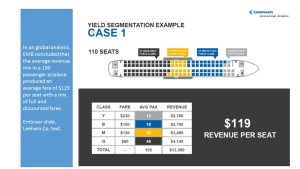Leeham News and Analysis
There's more to real news than a news release.
 Leeham News and Analysis
Leeham News and Analysis
- Solid start for stand-alone GE Aerospace despite cuts to LEAP output April 23, 2024
- SPEEA, Boeing at impasse over safety program, union says April 23, 2024
- Better transparency needed on Boeing’s 1Q earnings call April 22, 2024
- Bjorn’s Corner: New engine development. Part 4. Propulsive efficiency April 19, 2024
- Boeing unlikely to meet FAA’s 90-day deadline for new safety program April 18, 2024
Embraer ramps up smaller airplane messaging
May 28, 2015, c. Leeham Co. Embraer is ramping up is messaging that the E-Jet family provides a better Return on Capital Employed in many circumstance than the larger Airbus and Boeing single-aisle family.
In a new push to be unveiled at the Paris Air Show in a little over two weeks, Embraer will describe its “New Metrics for Success” to an international audience in an open forum.
EMB has been showing airlines and lessors the concept for some time, and we received a briefing on the essential elements when we visited EMB last October at is home base in San Jose, Brazil.
New Metrics for Success takes airlines away from the traditional metric of economics, the Cost per Available Seat mile, and focuses trip costs and the higher quality revenue obtained by limiting the number of low-yield seats on a flight that must be offered to fill larger airplanes.
“We focus on return on capital employed (RACE),” Rodigo Souza, VP-Marketing, said in an interview with Leeham News. “This is not an E-Jet speech. It could be about the CSeries, the CS100, the CRJ. It’s about 70 to 130 seats. It doesn’t matter which aircraft is there.”
The message is getting through. “US carriers are talking much more about providing an adequate return to investors.”
Evolving industry
The airline industry worldwide is evolving, Souza said. There has been major consolidation in the US and tremendous growth in the low cost airline sector. LCCs now command 45% of the North American market (Canada, US, Mexico), up 10 points from 2004. Europe has seen LCCs grow from 18% to 42% of the market and Asia has gone from 6% to 34%. In real dollars, revenue has gone down since 2009 from $2.40 per RTK to less than a dollar. Opportunities for ancillary revenue have about peaked out, EMB believes. Maximizing profits means adjusting thinking from the unit cost to RACE, EMB says.
In a global analysis of airline flights and revenue, Embraer concludes that the 110 seat airplane, although producing about 15% lower revenue than a 174 seat airplane, provides a greater RACE because of the lower capital and operating costs of the smaller aircraft. The smaller aircraft produces a return on aircraft asset (ROaA) 36% great compared with the larger aircraft.
Embraer uses the average of three appraiser current market values as the basis of the aircraft cost in making its computations.
Souza said an airline shouldn’t be focused on market share. “The purpose of business in not to increase market share. It’s one metric to consider. The prime purpose is return on capital employed.”
Embraer has long argued “right-sizing” the aircraft, replacing Airbus A319s and A320s or Boeing 737-700s and 737-800s on certain routes and certain times to better meet demand. A high fuel price environment has also been a significant factor.
Current factors
The current lower fuel price environment is spurring a pause by some airlines in placing orders for new jets. United Airlines recently agreed to lease up to 25 used A319s from AerCap as these come off lease from China Southern Airlines. Low fuel prices and low current and future market values of the A319s, leading to low lease rates (believed to be below $100,000/mo by the time UAL begins to take delivery) prompted the deal. United is going to push down E-175s into smaller markets, with a knock-on effect of regional jets pushing down to retiring the 50-seat Bombardier CRJs.
Souza said Embraer looks at this as a temporary phenomenon.
“The A319 and 737-700 at low lease rates are an easier solution with low fuel prices (for those airlines with these types already in their fleet), but it is temporary. We don’t see fuel prices staying very low forever, or cheap A319s and 737s available forever,” Souza said. “The one that loses more right now is the CSeries.
“We predict oil will be back to $90/bbl by 2020 and beyond.”
Related
Category: Airbus, Airlines, Boeing, Bombardier, CSeries, E-Jet, Embraer
Tags: 737-700, 737-800, A319, A320, Airbus, Boeing, Bombardier, CSeries, E-Jet, Embraer, Return on Capital Employed, United Airlines
5 Comments on “Embraer ramps up smaller airplane messaging”
Leave a Reply Cancel reply
Email Subscription
Twitter Updates
My TweetsAssociations
Aviation News-Commercial
Commentaries
Companies-Defense
Resources
YouTube
Archives
- April 2024
- March 2024
- February 2024
- January 2024
- December 2023
- November 2023
- October 2023
- September 2023
- August 2023
- July 2023
- June 2023
- May 2023
- April 2023
- March 2023
- February 2023
- January 2023
- December 2022
- November 2022
- October 2022
- September 2022
- August 2022
- July 2022
- June 2022
- May 2022
- April 2022
- March 2022
- February 2022
- January 2022
- December 2021
- November 2021
- October 2021
- September 2021
- August 2021
- July 2021
- June 2021
- May 2021
- April 2021
- March 2021
- February 2021
- January 2021
- December 2020
- November 2020
- October 2020
- September 2020
- August 2020
- July 2020
- June 2020
- May 2020
- April 2020
- March 2020
- February 2020
- January 2020
- December 2019
- November 2019
- October 2019
- September 2019
- August 2019
- July 2019
- June 2019
- May 2019
- April 2019
- March 2019
- February 2019
- January 2019
- December 2018
- November 2018
- October 2018
- September 2018
- August 2018
- July 2018
- June 2018
- May 2018
- April 2018
- March 2018
- February 2018
- January 2018
- December 2017
- November 2017
- October 2017
- September 2017
- August 2017
- July 2017
- June 2017
- May 2017
- April 2017
- March 2017
- February 2017
- January 2017
- December 2016
- November 2016
- October 2016
- September 2016
- August 2016
- July 2016
- June 2016
- May 2016
- April 2016
- March 2016
- February 2016
- January 2016
- December 2015
- November 2015
- October 2015
- September 2015
- August 2015
- July 2015
- June 2015
- May 2015
- April 2015
- March 2015
- February 2015
- January 2015
- December 2014
- November 2014
- October 2014
- September 2014
- August 2014
- July 2014
- June 2014
- May 2014
- April 2014
- March 2014
- February 2014
- January 2014
- December 2013
- November 2013
- October 2013
- September 2013
- August 2013
- July 2013
- June 2013
- May 2013
- April 2013
- March 2013
- February 2013
- January 2013
- December 2012
- November 2012
- October 2012
- September 2012
- August 2012
- July 2012
- June 2012
- May 2012
- April 2012
- March 2012
- February 2012
- January 2012
- December 2011
- November 2011
- October 2011
- September 2011
- August 2011
- July 2011
- June 2011
- May 2011
- April 2011
- March 2011
- February 2011
- January 2011
- December 2010
- November 2010
- October 2010
- September 2010
- August 2010
- July 2010
- June 2010
- May 2010
- April 2010
- March 2010
- February 2010
- January 2010
- December 2009
- November 2009
- October 2009
- September 2009
- August 2009
- July 2009
- June 2009
- May 2009
- April 2009
- March 2009
- February 2009
- January 2009
- December 2008
- November 2008
- October 2008
- September 2008
- August 2008
- July 2008
- June 2008
- May 2008
- April 2008
- March 2008
- February 2008






This is a funny but crooked analysis.
Case 2 has a lower revenue per seat but does generate 30% revenue than Case 1 (15800 vs 11900$).
This is the very reason why LCC stay afloat – reducing their cash flow would not help.
And another thing, price normally wins out. If the Case 2 airline can cover its costs with the cheap class Q passengers that the Case 1 airline doesn’t want, it can then pitch for the higher value class M to Y passengers. It can compete for them on price as well as convenience. The Case 2 airline is sunk if the number of premium passengers falls or the price they pay falls.
There’s a reason for the success of LCC’s on short haul and Emirates on long haul
The right plane for the right market is the way to go, this seems to be the right message to airlines. All we ear is Airbus buzzing about the 160-200 seat market and how they will fill this market, it is not one size fits all. This is a breath of fresh air in the aviation and good to see that Embraer is pulling with Bombardier in the same direction.
I think Embraer made the right decision with their E2 specifications. Needless to say they are enlarging their aircraft too 😉
The fact is that the LCCS as a whole are already doing very well financially, and they have achieved that in the early years with A319 and 737-700 sized aircraft.
Having grown their business, the established LCC are now up-sizing to A320 sized modules, 737-800, to maintain volume and revenue growth. They are not going to start downsizing their modules.